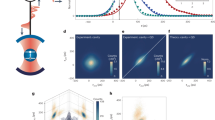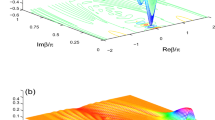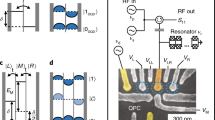Abstract
The theory of the quantum information transmission between two semiconductor two-level quantum dots as two qubits through an intermediary photon gas in a cavity is presented. The reduced density matrix of each two-level quantum dot is the quantum information encoded into this qubit. The quantum information exchange between two distant qubits imbedded in the photon gas is performed in the form of the mutual dependence of their reduced density matrices due to the interaction between the electrons in the qubits and the photon gas. The system of rate equations for the reduced density matrix of the two-qubit system is derived. From the solution of this system of equations it follows the mutual dependence of the reduced density matrices of two distant qubits.
Similar content being viewed by others
References
J. I. Cirac, P. Zoller, H. J. Kimble, and H. Mabuchi, “Quantum State Transfer and Entanglement Distribution among Distant Wides in a Quantum Network”, Phys. Rev. Lett. 78, 3221 (1997).
A. Imamoglu, D. D. Awschalom, G. Burkard, D. P. DiVincenzo, D. Loss, M. Sherwin, and A. Small, “Quantum Information Processing Using Quantum Dot Spins and Cavity QED,” Phys. Rev. Lett. 83, 4204 (1999).
Lu-Ming Duan, J. I. Cirac, P. Zoller, and E. S. Polzik, “Quantum Communication between Atomic Ensembles Using Coherent Light,” Phys. Rev. Lett. 85, 5643 (2000).
D. E. Browne, M. B. Plenie, and S. F. Huelga, “Robust Creation of Entanglement between Ions in Spatially Separate Cavities,” Phys. Rev. Lett. 91, 067901 (2003).
L. Childress, J. M. Taylor, A. S. Sorensen, and M. D. Lukin, “Fault-Tolerant Quantum Communication Based on Solid-State Photon Emitters,” Phys. Rev. Lett. 96, 070504 (2006).
P. van Loock, T. D. Ladd, K. Sanaka, F. Yamaguchi, Koe Nemoto, W. J. Munro, and Y. Yamamoto, “Hybrid Quantum Repeater Using Bright Coherent Light,” Phys. Rev. Lett. 96, 240501 (2006)
D. Press, S. Götzinger, S. Reitzenstein, C. Hofmann, A. Löffler, M. Kamp, A. Forchel, and Y. Yamamoto, “Photon Antibunching from a Single Quantum-Dot-Microcavity System in the Strong Coupling Regime,” Phys. Rev. Lett. 98, 117402 (2007).
S. M. Clark, Kai-Mei C. Fu, Th. D. Ladd, and Y. Yamamoto, “Quantum Computers Based on Electron Spins Controlled by Ultrafast Off-Resonant Single Optical Pulses,” Phys. Rev. Lett. 99, 040501 (2007).
Author information
Authors and Affiliations
Corresponding author
Additional information
The article is published in the original.
Rights and permissions
About this article
Cite this article
Hieu, N.V., Ha, N.B., Puzynin, I.V. et al. Quantum information transmission between two qubits through an intermediary photon gas. Phys. Part. Nuclei Lett. 6, 513–515 (2009). https://doi.org/10.1134/S1547477109070036
Published:
Issue Date:
DOI: https://doi.org/10.1134/S1547477109070036




